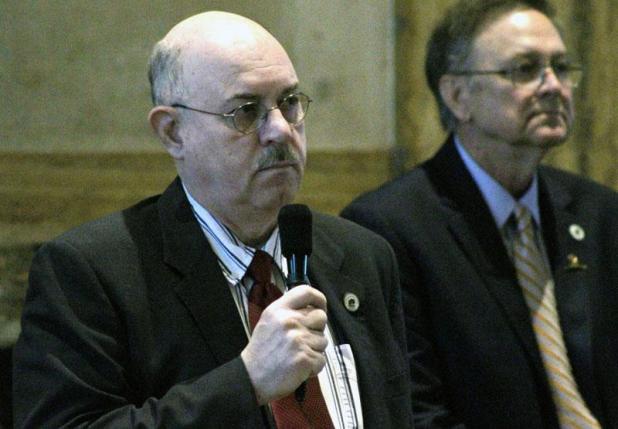
Manship School News Service/William Taylor Potter
Rep. Sam Jones, D-Franklin, in the well of the House chamber.
New business tax introduced
BATON ROUGE – A key part of Gov. John Bel Edwards’ tax plan quietly was introduced to the House on Monday in the form of House Bill 628 by Rep. Sam Jones, D-Franklin, which would place a tax on gross receipts of businesses. It faces an uncertain future.
The commercial activity tax – often called the CAT – focuses on the total amount of revenue an organization receives from all sources, without deducting expenses. The tax would apply to most businesses, regardless of the organizational structure.
“Right now, individuals in Louisiana are overly burdened by our current tax and budget structure, while too many businesses use costly credits and exemptions to avoid paying any corporate income taxes,” Edwards maintains.
The new tax has been criticized by Republicans and has been greeted with a lukewarm response from Democrats. In his State of the State address opening the current legislative session, Edwards emphasized the tax would be “fixed and minimal.”
There was no debate on HB628 and it will be referred to a committee Tuesday.
Entities subjected to the CAT would be partnerships, limited liability companies, limited liability partnerships, corporations, S corporations, joint ventures and disregarded entities. Those exempted include non-profit organizations, governmental entities, some public entities, certain insurance companies and financial institutions, and businesses with $1.5 million or less in taxable gross receipts.
Edwards’ original CAT plan was modified slightly with HB628. Pass-through businesses, such as partnerships and limited liability companies, would be charged a flat rate. For these companies, the rate ranges from $250 for business with receipts of at least $150,000, and $12,500 for those with more than $12 million.
Other businesses with taxable gross receipts between $1.5 million and $3million would be taxed according to a complex formula that would take the difference between the business’ taxable gross receipts and $3 million. That difference will be multiplied by 5,250, then divided by $1.5 million. That result will be subtracted from 0.35 percent times the taxable gross receipts.
For example, if a dentist’s office makes $2.5 million in annual gross receipts, the $2.5 million would be subtracted from $3 million, which is the maximum for this tier. The difference, $500,000, would be multiplied by 5,350, which would be roughly $2.625 billion. That result will be divided by $1.5 million – the minimum for the tier – to get $1,750. That number will be subtracted from .35 percent of the taxable gross receipts, or $2.5 million, which would be $7,000. That office would pay $7,000 on its $2.5 million in gross receipts.
The system is simpler for businesses with over $3 million in taxable receipts. A business would pay .35 percent of its gross receipts. If that same dentist’s office had $4 million in taxable receipts, it would pay $14,000.
Businesses with taxable gross receipts less than $1.5 million do not have to pay the CAT, but instead would pay the minimum commercial activity tax, or MCAT, which ranges from $250 to $750, depending on the level of gross receipts.
While the Louisiana Budget Project (LPB), a group that analyzes the state’s fiscal issues, said the governor’s overall plan would give 95 percent of Louisiana’s families a tax cut, the analysis was less favorable of CAT.
The project’s report said the tax is expected to generate $832 million per year, but there is the risk of a deficit if the tax does not generate the projected revenue in its first year. LPB also found the tax would hit low- and middle-income people harder, with the average middle-income family paying an estimated $198 per year.
